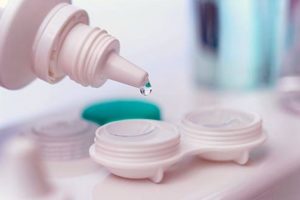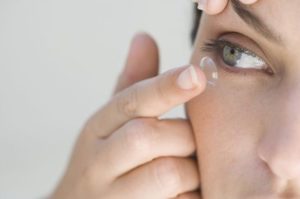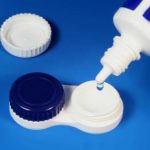Contact lenses
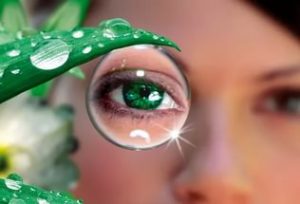 This article is an overview, in which we will introduce you to the articles on our site; you can study the topic of interest in more detail by following the links. The contact lenses section will tell you about the purpose of contact lenses for vision correction in the presence of deviations from the norm.
This article is an overview, in which we will introduce you to the articles on our site; you can study the topic of interest in more detail by following the links. The contact lenses section will tell you about the purpose of contact lenses for vision correction in the presence of deviations from the norm.
They are comfortable to use and have a high level of convenience. The modern development of contact vision correction allows people with poor vision to do without surgical intervention and still feel quite comfortable.
Contact lenses: pros and cons
Lenses have a number of advantages over glasses:
- ease of use;
- possibility of exploitation by athletes;
- high level of vision quality.
A distinctive feature of the product is the formation of a single optical system between the lens and the eye, which leads to the absence of some distance between the correction material and the pupil. Therefore, the correction effect in this case is much higher than when wearing glasses. Often this fact influences the choice of consumers in favor of lenses, since for many, a large distance between glasses and eyes has a bad effect on the overall comfort and condition of a person.
There are a number of disadvantages that sometimes scare beginners:
- constant care of the product is required;
- self-installation of lenses;
- the presence of a foreign body on the cornea;
- It is imperative to follow all recommendations for wearing and caring for the corrective product.
Considering these facts, it can be noted that lenses are absolutely harmless if they are used correctly and are constantly cared for. Learn more You can read about the pros and cons of contact lenses here.
How to care for contact lenses
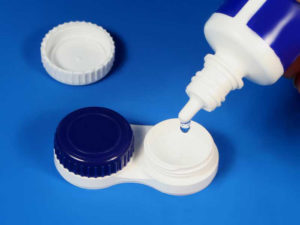 Here you should carefully follow the recommendations for the product. A compatible solution is required. It cannot be reused, so frequent replacement of the product is mandatory - this will prevent the growth of bacteria. The procedure includes the following manipulations:
Here you should carefully follow the recommendations for the product. A compatible solution is required. It cannot be reused, so frequent replacement of the product is mandatory - this will prevent the growth of bacteria. The procedure includes the following manipulations:
- cleaning from accumulated bacteria;
- mandatory disinfection;
- specialized storage.
Today you can purchase one product that can perform all three manipulations - this simplifies the care process and reduces the percentage of costs. Read more How to properly care for contact lenses can be found here.
Interesting: There are options for lenses for long-term wear that do not require daily removal, but before purchasing them, consultation with an ophthalmologist is required.
Is it possible to replace a specialized solution?
This is a pressing question from consumers. The product care product is a saline solution, which is prepared under special conditions and proportions. But there are often times when there are no opportunities to purchase it. In this case, distilled water can be used for storage. It can be obtained by boiling raw water and condensing it. It can be used to wash items, but thorough cleaning is not possible. Therefore, it is necessary to add a small amount of salt to the liquid.
Second option - This is hydrogen peroxide, it will clean and disinfect lenses. But before using them, you should thoroughly rinse them to remove any remaining peroxide; getting it on the cornea is fraught with consequences.
Important: When preparing any solution, complete sterility is required.
It should be understood that substitutes cannot be used for an extended period of time, as this is an alternative option for emergency situations. Also You can read about contact lens solution and how you can replace the solution here.
We warn you: The article is for informational purposes only, so you cannot make your own substitute based only on this text. Before using an alternative option, you should consult a specialist.
Proper storage of the product is the key to the health of your eyes
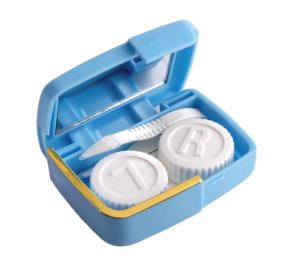 Care should be carried out daily, but it also requires store contact lenses correctly, to prevent their damage.
Care should be carried out daily, but it also requires store contact lenses correctly, to prevent their damage.
Unopened version can be stored at room temperature for as long as indicated. After opening, it is advisable to consider the following recommendations:
- use only disinfectant;
- container use;
- Do not use plain water to rinse a special vessel;
- reuse of the solution is unacceptable.
Considering these recommendations, you don’t have to worry about your eye health. If the lens falls, it must be washed with solution before use. If you experience any unpleasant sensations, such as pain in the eyes, burning or discomfort, you need to remove the corrective product and clean it.
We put on and remove lenses correctly
There are certain rules that must be followed when putting on and removing lenses:
- Before the procedure, you need to wash your hands well with soap, rinse with clean water and wipe dry with a lint-free towel;
- you need to check that they are positioned correctly and that they are not turned inside out. To do this, you need to place the lens on the tip of your finger to make sure that its edges are smooth without deformation;
- During the procedure, you need to hold the upper eyelid to prevent sudden blinking;
- Next, you need to pull back the lower part of the eyelid and confidently place the lens;
- The last stage is to slowly close your eyes for a while.
 We carry out the whole process step by step with the second eye, the main thing is to remain calm and confident during the procedure.
We carry out the whole process step by step with the second eye, the main thing is to remain calm and confident during the procedure.
When removing the product, you must follow the same rules of hygiene and sterility. To remove it, use the pinch method; you need to stand in front of a mirror and tilt your head forward and look up. Next, we move the corrective product down and carefully pull it forward to remove it.
Let's talk about the rules of use and possible discomfort
Contact lenses must be used in accordance with established standards; if recommendations are not followed, side effects may occur. Let's take a closer look, how to properly put on and remove contact lenses.
How long can you wear contact lenses?
 Ophthalmologists say that optimal time to wear contact lenses – this is a daytime period, but if night use is required, then consultation with a specialist is advisable. There are certain rules according to which you need to start using the product. Initially, you need to give your eyes time to get used to the foreign body. On the first day, use is allowed for no more than four hours, followed by an increase of one hour.By the end of the week, it is possible to use the product for half a day.
Ophthalmologists say that optimal time to wear contact lenses – this is a daytime period, but if night use is required, then consultation with a specialist is advisable. There are certain rules according to which you need to start using the product. Initially, you need to give your eyes time to get used to the foreign body. On the first day, use is allowed for no more than four hours, followed by an increase of one hour.By the end of the week, it is possible to use the product for half a day.
There is a division according to models, according to which time frames are established. Daily contact lenses are good for no more than 12 hours, then they are replaced with new ones. It is advisable to use colored devices for no more than 8 hours. There are a number of models, which are classified into weekly, fortnightly, monthly - it depends on the manufacturer. Silicone - the hydrol version can be used for up to 15 hours, even at night.
When does dry eye occur?
 When using contact lenses, you may experience dry eyes, since a foreign body is inherently a disruptor of the normal functioning of the tear film, therefore there is no proper hydration. In this case, you should consult an ophthalmologist to prescribe special eye drops to additionally moisturize the cornea.
When using contact lenses, you may experience dry eyes, since a foreign body is inherently a disruptor of the normal functioning of the tear film, therefore there is no proper hydration. In this case, you should consult an ophthalmologist to prescribe special eye drops to additionally moisturize the cornea.
Attention: If you feel severe discomfort and pain in your eyes, it is advisable to immediately remove the lenses and consult a specialist.
Radius of curvature of contact lenses
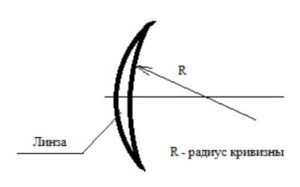 The lens is placed on the cornea itself, which has a convex surface, so it is important to choose the correct radius of curvature of the “contacts”so as not to experience discomfort during operation. When using a product with a small radius, squeezing of blood vessels is possible, and with a large radius, operation is uncomfortable. When purchasing, you should pay attention to this value; it is indicated by the manufacturer on the packaging. To determine the required size, you need to seek help from an ophthalmologist.
The lens is placed on the cornea itself, which has a convex surface, so it is important to choose the correct radius of curvature of the “contacts”so as not to experience discomfort during operation. When using a product with a small radius, squeezing of blood vessels is possible, and with a large radius, operation is uncomfortable. When purchasing, you should pay attention to this value; it is indicated by the manufacturer on the packaging. To determine the required size, you need to seek help from an ophthalmologist.
Types and types of contact lenses
Classification is carried out according to several criteria:
- hardness - they are soft and hard, and are also grouped according to the degree of moisture of the product;
- period of operation - determined by the manufacturer, one-day and monthly options are possible;
- shape – spherical, toric, multifocal, prescribed based on the type of eye disease;
- purpose – there is a corrective and decorative model to give depth of color;
- degree of transparency.
Each model has its own characteristics, so the decision to choose types of contact lenses should only be taken with an ophthalmologist.
Types of product materials
Based on this fact, contact lenses are classified into three types:
- soft products, a jelly-like polymer is used in production;
- hard versions are made of gas-permeable silicone;
- Plexiglas lenses are currently an outdated option.
Silicone - hydrogel materials have earned high popularity among lens manufacturers. They allow oxygen to pass through well and have a lower percentage of dehydration. More details Read about contact lens material here.
How to choose contact lenses
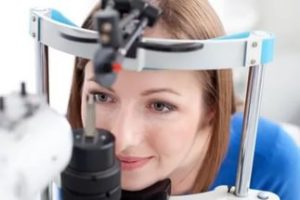 This is the last point of our review article; the right choice greatly affects the preservation of eye health. To do this, you need to rely on the following recommendations:
This is the last point of our review article; the right choice greatly affects the preservation of eye health. To do this, you need to rely on the following recommendations:
- Initially, you need to undergo a full examination by an ophthalmologist;
- Next, the type and manufacturer of the product is determined, here you need to rely on the doctor’s recommendations;
- the next point is determining the frequency and duration of use;
- the last point is the purpose, the choice depends on whether it is required for vision correction or simply as a decorative element.
Read a detailed article on choosing contact lenses here.
Attention: independent choice of contact lenses is excluded; a preliminary consultation with an ophthalmologist and compliance with his recommendations are required.




